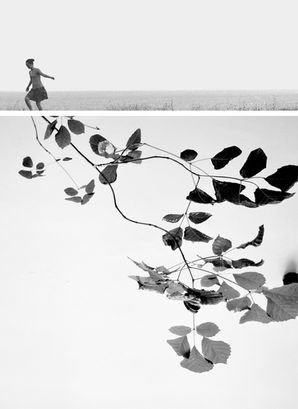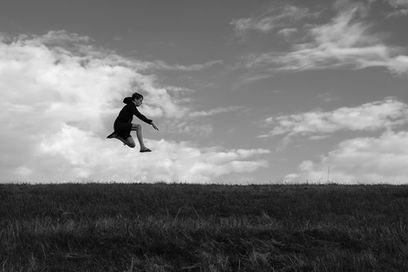
ARCHITECTURALLY COMPOSED
August 12, 2020
INTERVIEW
PHOTOGRAPHY Gino Ricardo
INTERVIEW Melanie Meggs
Gino Ricardo is a motion graphic designer with a passion for pattern and a curiosity for exploration. But it wasn't until June 2019 that he decided to take his camera to work with him on a daily basis and explore the city during his lunch breaks. What started as one hour lunch break sessions quickly blossomed into weekend excursions, documenting the architecture and street photography of places unknown to him. As he ventured around the cities he visited, Gino found comfort in being alone and taking pictures of the exquisite buildings he encountered. It was then that he realized that his camera didn't have to just collect dust on the shelf; it could be used to capture the beauty of the world. Thus began Gino's journey of discovering the wonders of the world through his lens.

“I started photography about a year ago. In September 2018 I bought a “serious” camera (Panasonic GH5 ) to film my three week trip to South Africa. The camera was bought with the intention to film my South Africa adventure and future trips and on occasion take pictures. After the trip I felt like it was a waste of money that the camera would just sit at home on a shelf collecting dust. At one point in 2019 I started to take my camera to work and use my one hour lunch break to take pictures. Before I knew it photography became a bit of an obsession.”
IN CONVERSATION WITH GINO RICARDO
THE PICTORIAL LIST: The way you see architecture is not the usual way people would see it - graphic and composed precision. How do you find the composition when you are searching for that shot? What are some of the elements you try to include to make a good architecture image? And what do you do post-process?
GINO RICARDO: Thank you very much for the compliment! When shooting architecture I always look for lines, patterns, details, textures, reflections and shadows in a building. Sometimes I see a building and know what I want to shoot and how to get the result I want. Other times it comes down to trial and error. I try different compositions and angles, from long to medium to close ups. Trying to find a way to make the work click. A lot of times I visit the same place multiple times and take the same shot in different circumstances or discover a new vantage point. I like to keep my images simple.
I do some post-processing. It begins with setting a building straight and cropping. Usually I bump up the contrast and make the shadows darker. Sometimes I dodge and burn some elements in my images, and on occasion I Photoshop little imperfections out of a frame. For instance a spec of light that is drawing attention in a scene where I don't want the attention to go. But usually I try avoiding this and keeping the image as authentic as possible.
TPL: You also shoot street photography and include them among your architecture photos in your Instagram gallery. Do you do anything differently to how you shoot and compose your architecture shots?
GR: In street photography I mostly look for light and shadows. The difference between street and architecture is that for street I am solely relying on sunlight. So when it is raining you won't see me taking any street photos - unless you have beautiful reflections. For architecture I photograph all the time, it doesn’t matter if it rains or the sky is grey. I still need to learn a lot about street photography and keep developing this.
To be honest, street photography is a side hustle. Mostly I go out to get my architecture shots and then switch to street afterwards or when I see something interesting happening. The difference between street and architecture is the pace. You have to be on your feet and think fast. A moment is gone before you know it. In that moment you have to be able to take the picture or try another time. A lot of times I see good light and wait a bit for something interesting to happen. This can be a minute or ten. Architecture is slower paced. I can walk around a building and observe it and put more thought into what I want or what is interesting.
TPL: Where is your favourite place to photograph?
GR: For now my favourite place to shoot is in Rotterdam, Netherlands. I am always surprised by the new places that I see and am looking forward to new spots to discover.
TPL: Has your style of photographing changed since you first started?
GR: Yes definitely, I started with photos from my holiday and then started going to the city to practice my shooting. Shooting street and architecture. During this period I noticed that I like black and white architecture photography more. I also started to shoot more often with zoom lenses to get those detailed shots/close ups. First I used my 45-200mm zoom and after a while my girlfriend's 75-300mm lens. Also my images became a lot darker.
The best images aren’t at the end of an expensive flight. They are just around the corner from your house if you are willing to take a walk and really see. - Sean Tucker

TPL: Do you think equipment is important for achieving your vision in your photography? What would you say to someone else just starting out?
GR: I think that the camera is just a tool, nothing more nothing less. The typewriter never wrote a book, but the writer did. The same applies for a photographer. Having said that I really like the system that I have, the portability of the body and lenses are just great in terms of weight. When hitting the streets I have two lenses with me and that is it. Making it very easy for me to travel with.
For someone who is just starting out I would advise them not to look to much at the specs of a camera but just start shooting. These days technology is so advanced that any camera you buy as a beginner will be a good camera. Use the time when you are beginning to discover what you like and develop yourself. Keep in mind that your needs can change over time as you develop as a photographer. If you can’t afford a camera in the beginning start with your phone.
TPL: Do you have any favourite artists you would like to share with us, and the reason for their significance?
GR: I definitely look up to photographers like Alan Schaller and Sean Tucker, Sebastiao Salgado, Fan Ho to name a few. I think that I got heavily inspired by Sean and Alan. I really like the philosophical side of Sean’s work and ethics and the super dark moody tones and diversity of Alan's work. I also get inspired a lot by other photographers whom I discovered through Instagram. I also follow artists like Lindsay Adler, Platon, Maarten Rots, and David Yarrow. Their work is so different from my own. I think that it is a must to keep an eye out for other artists who have absolutely nothing to do with your own work. Giving you a fresh perspective.
TPL: Have you ever been involved in the artistic world before photography?
GR: Yes, I am a 2D animator/motion graphics designer.
TPL: Are there any special projects you are currently working on?
GR: Yes, I recently created my first book and made a video about it. I would love to go back out and travel to London, Paris and discovering some other countries. But due to COVID-19 this is pretty difficult. Time will tell when this is possible again but in the meantime there is lots to discover in my own town and country. And in the upcoming weeks I am going to create a short film.
TPL: If I wasn't photographing what would I be doing?...
GR: Animating and designing for animation.

Gino Ricardo's story is a testament to the power of exploration. His unique perspective and passion for photography has allowed him to capture the beauty of the architecture around him. His journey of discovery has been inspiring and his work is a reminder of the beauty that can be found around us. We can all learn from Gino's example and find the courage to explore our world through our own personal lens. Use the links below to view Gino's work and gain some inspiration.



































